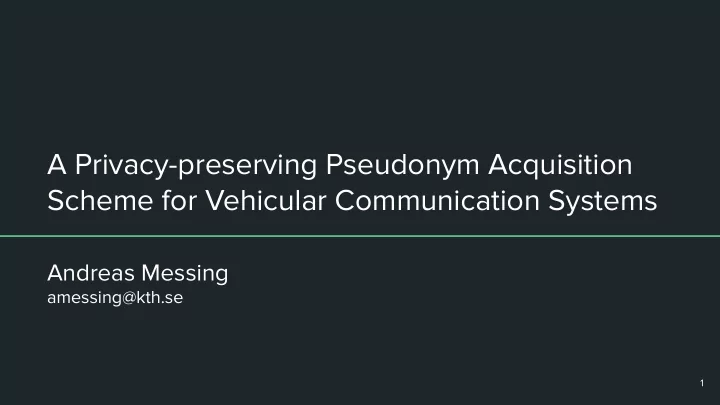

A Privacy-preserving Pseudonym Acquisition Scheme for Vehicular Communication Systems Andreas Messing amessing@kth.se 1
Vehicular Communication Systems ● Smart Cities ● Self-driving Transportation Systems ● Vehicle-to-Vehicle Communication ● Security and Privacy 2
Cooperative Awareness Message (CAM) ● State of the vehicle ● Environmental information ● Vehicles broadcast 3-10 CAMs per second ● Authenticity, integrity, and non-repudiation ● Pseudonym - anonymous identity ● User privacy Trackable during one pseudonym ● ● Frequently switch to a new pseudonym 3
Vehicular Public Key Infrastructure (VPKI) ● Root Certificate Authority (RCA) Trust between regions ○ ● Long-Term Certificate Authority (LTCA) ○ Long-Term Certificate ● Pseudonym Certificate Authority (PCA) ○ Pseudonym issuing Resolution Authority (RA) ● ○ Identity Resolution ● Road-Side Unit (RSU) M. Khodaei, et al., “SECMACE: Scalable and Robust Identity and Credential Management Infrastructure in Vehicular Communication 4 Systems,” in the IEEE TITS, Mar. 2018
Pseudonym Refilling Strategies Preloading schemes ● ○ Computationally costly, inefficient utilization, cumbersome revocation ● On-demand schemes ○ Efficient in utilization & revocation; effective in fending off misbehavior ○ The more frequent interactions, the more dependent on connectivity 5
Group Signatures ● Many private keys, one shared public key ● Privacy in the group ● Computationally expensive Self-signed pseudonyms ● 6
Problem Statement and Challenges ● Unavailability of the VPKI ○ No RSUs in range ○ Cellular network overloaded ○ Denial of Service attacks ● Unable to acquire pseudonyms Hybrid scheme 1 (baseline): issuing self-signed pseudonyms ● ● Vehicles without VPKI pseudonyms would “stand out in a crowd”: ○ Different pseudonym signature and timing information 1 G. Calandriello et al., “On the Performance of Secure Vehicular Communication Systems,” IEEE TDSC, vol. 8, no. 6, pp. 898–912, Nov. 2011. 7
Linking Attacks ● Linking Pseudonyms ● Syntactic Linking ○ Lifetime ○ Signature ● Solution ○ Aligned Lifetimes ○ Same Signer (PCA) ● Semantic Linking 8
Adversarial Model ● Linking subsequent pseudonyms ● Sybil-based Attacks ● DoS attacks 9
Rhythm - Randomized Hybrid Scheme To Hide in a Mobile Crowd ● Add Group Manager in every region ○ Self-signed Pseudonyms No Syntactic Linking protection ○ ● Registration Phase ○ Register anonymously with GM ● Align Lifetime to VPKI Pseudonyms ○ Easily obtained information Solved Syntactic Linking based on lifetime ○ ● Solve Syntactic Linking based on signature 10
Rhythm - Syntactic Linking Based on Signature ● Every vehicle with a VPKI pseudonym randomly decides to use a self-signed pseudonym ● R = Probability of using self-signed pseudonym in next pseudonym switch ● Decreases the probability of linking a self-signed pseudonym without increasing the probability of linking a VPKI pseudonym 11
Security Analysis ● Authenticity, integrity, and non-repudiation Provided by pseudonyms ○ ● Thwarting Sybil-based Attacks ○ Group signatures can limit the amount of valid signatures that can be made at the same time ○ Hardware Security Module (HSM) ensures signatures under one private key of a single valid pseudonym ● Thwarting Denial of Service (DoS) attack ○ Ignoring Rhythm initiation query if VPKI is reachable Rhythm only lasts while the VPKI is out of reach ○ 12
Privacy Analysis ● M = Number of vehicles without VPKI pseudonyms ● 100 vehicles, R = 0.2 Metric: Probability of Linking ● ● significant privacy enhancement ● without affecting privacy of others 13
Privacy Analysis ● Linking from VPKI to VPKI Linking from self-signed to self-signed ● ● Vehicles that do not use Rhythm gets slightly increased linkability 14
Performance Evaluation ● Group Signatures are more than 10x slower ● When R = 0, vehicles can handle 140 neighbors ● When R = 1, vehicles can handle 100 neighbors 422 - 135 = 287 ms overhead for 10 pseudonyms ● ○ R = 0.5 ● C, OpenSSL, an implementation of short group signature: Pairings in C 15
Conclusion + Future Work ● Using Rhythm, privacy is preserved for vehicles that cannot connect to the VPKI at the cost of a reasonable computation overhead. ● The privacy of vehicles that have VPKI pseudonyms is slightly increased when using Rhythm. The privacy for those that do not use Rhythm is decreased. ● Deciding the optimal value on R is situational and is left as future work. ● How far the initialization query should propagate is left as future work. More incentive for vehicles to use Rhythm. ● 16
Thank you for listening! 17
Pseudonym Acquisition 1. Generate key pairs 2. Request token from LTCA 3. Acquire token from LTCA 4. Request a set of pseudonyms from PCA a. Send public keys + token 5. Acquire a set of pseudonyms from PCA M. Khodaei, et al., “SECMACE: Scalable and Robust Identity and Credential Management Infrastructure in Vehicular Communication Systems,” in the IEEE TITS, Mar. 2018 18
Rhythm - Affect on Semantic Linking ● Semantic Linking is independent of the pseudonym. Rhythm should therefore be compatible with a solution to Semantic Linking. ● Initialization query in a CAM does not make that CAM more linkable. A solution to Semantic Linking would make the pseudonyms entirely ● unlinkable in the system. 19
Recommend
More recommend